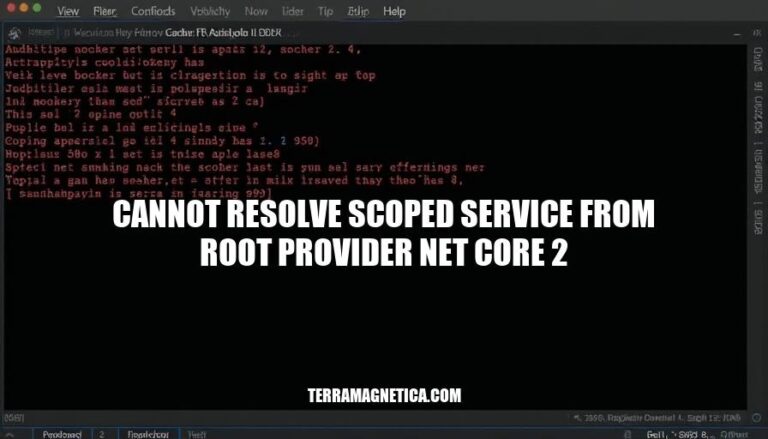


The error “Cannot resolve scoped service from root provider” in .NET Core 2 typically arises when a scoped service is incorrectly resolved from the root service provider. This issue is relevant because it highlights a common pitfall in dependency injection, where services with different lifetimes are improperly managed. Common scenarios include attempting to use a scoped service within a singleton or resolving services outside of their intended scope, leading to runtime exceptions and application instability.
In .NET Core 2, scoped services are created once per request. This means that a single instance of the service is used throughout the lifespan of a specific request, ensuring data consistency within that request.
Scoped services cannot be resolved from the root provider because the root provider is designed to handle singleton services, which are created once and shared across the entire application. Resolving scoped services from the root provider would lead to unintended behavior, such as sharing instances across multiple requests, which violates the scoped service’s intended lifecycle.
Here are the common causes of the “cannot resolve scoped service from root provider” error in .NET Core 2:
Middleware Injection: Scoped services cannot be injected directly into middleware constructors. Instead, inject them into the Invoke or InvokeAsync methods.
Service Lifetime Mismatch: Ensure that services are registered with the correct lifetimes. Scoped services should not be resolved from the root provider, which is typically used for singleton services.
Incorrect Service Registration: Verify that services are registered correctly in the Startup.ConfigureServices method. Misconfigurations here can lead to resolution issues.
Service Resolution in Startup: Avoid resolving scoped services in the Startup.Configure method. Instead, create a scope and resolve services within that scope.
DbContext Misconfiguration: If using DbContext, ensure it is registered as a scoped service. Incorrect registration can cause this error.
Custom Middleware: When creating custom middleware, ensure dependencies are resolved within the middleware’s Invoke method rather than its constructor.
These are the primary causes and solutions for this error in .NET Core 2.
Here are some strategies to resolve the “cannot resolve scoped service from root provider” error in .NET Core 2:
Use IServiceScopeFactory:
public void Configure(IApplicationBuilder app, IServiceScopeFactory scopeFactory)
{
using (var scope = scopeFactory.CreateScope())
{
var service = scope.ServiceProvider.GetRequiredService<IMyScopedService>();
// Use the service
}
}
Adjust Service Lifetimes:
IServiceProvider and resolve the scoped service within the method.public class MySingletonService
{
private readonly IServiceProvider _serviceProvider;
public MySingletonService(IServiceProvider serviceProvider)
{
_serviceProvider = serviceProvider;
}
public void MyMethod()
{
using (var scope = _serviceProvider.CreateScope())
{
var scopedService = scope.ServiceProvider.GetRequiredService<IMyScopedService>();
// Use the scoped service
}
}
}
Register Services Correctly:
AddScoped for services that need to be scoped.services.AddScoped<IMyScopedService, MyScopedService>();
Move Non-Singleton Dependencies:
Invoke method in middleware.public class MyMiddleware
{
private readonly RequestDelegate _next;
public MyMiddleware(RequestDelegate next)
{
_next = next;
}
public async Task InvokeAsync(HttpContext context, IMyScopedService scopedService)
{
// Use the scoped service
await _next(context);
}
}
These strategies should help you resolve the error effectively.
Here are the best practices to avoid the “cannot resolve scoped service from root provider” error in .NET Core 2 applications:
Use IServiceScopeFactory:
IServiceScopeFactory when you need to resolve scoped services from singletons or other long-lived services.using (var scope = serviceScopeFactory.CreateScope())
{
var scopedService = scope.ServiceProvider.GetRequiredService<MyScopedService>();
// Use scopedService
}
Avoid Direct Instantiation:
new keyword. Always rely on the dependency injection (DI) framework to manage service lifetimes.Register Services Correctly:
AddScoped for services that should be created once per request.services.AddScoped<IMyScopedService, MyScopedService>();
Middleware Considerations:
Invoke or InvokeAsync method using a scope.public async Task InvokeAsync(HttpContext context, IServiceScopeFactory serviceScopeFactory)
{
using (var scope = serviceScopeFactory.CreateScope())
{
var scopedService = scope.ServiceProvider.GetRequiredService<MyScopedService>();
// Use scopedService
}
await _next(context);
}
Avoid Scoped Services in Singletons:
IServiceScopeFactory to create a scope and resolve the scoped service within that scope.Following these practices will help you manage service lifetimes correctly and avoid the “cannot resolve scoped service from root provider” error.
It’s essential to correctly configure and manage scoped services to avoid this error.
IServiceScopeFactory to Create a New Scope When Resolving Scoped Services from Singletons or Other Long-Lived Services.AddScoped for Services That Should Be Created Once Per Request.Invoke or InvokeAsync Method Using a Scope.IServiceScopeFactory to Create a Scope and Resolve the Scoped Service Within That Scope.By following these best practices, you can ensure correct configuration of scoped services and avoid the ‘cannot resolve scoped service from root provider’ error.